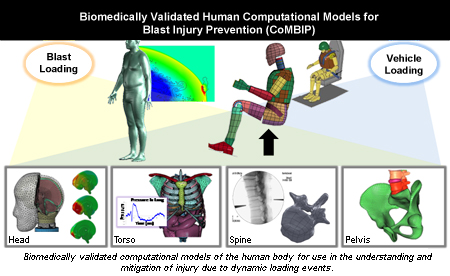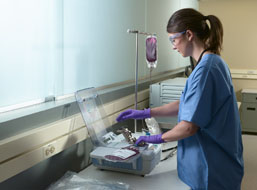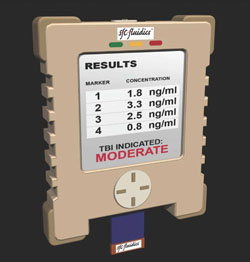Previously Funded
Deployment Related Medical Research Highlights
2012:
- Understanding Blast-related Injuries
- A Transportable Pathogen Reduction System for Treatment of Whole Blood
2011:
2012
Understanding Blast-related Injuries
Posted May 24, 2012
Andrew Merkle, M.S., Johns Hopkins University, Baltimore, Maryland
Explosive munitions and other improvised explosive devices continue to present a substantial threat to military and civilian personnel. Exposure to these blasts can cause acute injuries that can be prevented. However, the mechanism of these injuries is not well understood. Andrew Merkle, recipient of a Fiscal Year 2008 Deployment Related Medical Research Program Advanced Technology/Therapeutic Development Award, is developing biomedically validated human models capable of simulating and predicting blast-induced injury in multiple scenarios. Mr. Merkle and his trans-disciplinary team of engineers, scientists, and medical personnel, will identify the decisive mechanism through which the blast interacts with the human body and causes injury. These parameters will be used to develop computational models to simulate the blast in open field, enclosed, and vehicle-mounted scenarios. Head, neck, and thoracic models will be exposed to simulated blast conditions, and biomechanical measurements will be obtained and evaluated. This data will be combined with real-world data to allow developers to design, test, and evaluate personal and vehicle protection systems. Together, this work will help reduce the frequency and severity of these types of injuries.
Link:
A Transportable Pathogen Reduction System for Treatment of Whole Blood
Posted March 15, 2012
Raymond Goodrich, Ph.D., CaridianBCT Biotechnologies, Lakewood, Colorado
During combat, fresh whole blood (FWB) is used to treat life-threatening blood loss resulting from traumatic injuries when screened blood components are unavailable. While FWB may be critical in saving the lives of injured warriors, it is often transfused without any donor screening, nor standard viral testing. Additionally, FWB is used without leukoreduction, which introduces a large number of viable white blood cells into severely injured patients, potentially increasing the rate of infections among other serious immunological complications.
Dr. Raymond Goodrich and his research group, recipients of a Fiscal Year 2008 Deployment Related Medical Research Program Advanced Technology/Therapeutic Development Award, aim to develop a portable, disposable device for pathogen reduction in FWB which will minimize the risk of infectious disease transmission as well as potential adverse immunological affects of bypassing leukoreduction. With the award, Dr. Goodrich and his team are developing a prototype for the device (named the Mirasol System for Whole Blood) which uses riboflavin (vitamin B2) and UV light to rapidly inactivate pathogens and leukocytes in whole blood. Validation and optimization studies are being conducted for the device's effectiveness against pathogens including bacteria, viruses, and parasites. Dr. Goodrich plans on assessing the quality and safety of FWB for use in patients following Mirasol System treatment under various storage conditions. When completed, the Mirasol System will undergo operational testing in simulated combat environments.Link:
2011
Developing Diagnostics for the Rapid Assessment of Traumatic Brain Injury
Posted August 18, 2011
Calvin Goforth, Ph.D., SFC Fluidics, LLC, Fayetteville, Arkansas
Traumatic Brain Injury (TBI), which affects millions of civilians and military personnel, is typically diagnosed using a battery of neurologic exams along with an imaging modality, such as computed tomography (CT). However, TBI diagnosis using these current methods can be unreliable, and CT may lack the sensitivity necessary to diagnose mild injuries. Recent investigations demonstrate that in response to a head injury, a number of protein biomarkers exclusive to head injury are released into the blood stream, the quantities of which are directly proportional to the severity of injury. Although diagnostic protocols for determining the quantities of TBI biomarkers in the blood exist, time and logistical constraints limit their utility in rapidly diagnosing and triaging injured soldiers in the field. Thus, with funding from a FY08 DRMRP Advanced Technology/Therapeutic Development Award, SFC Fluidics is developing a portable and field-deployable handheld device capable of measuring biomarker quantities using a finger-prick blood sample to assess the presence and magnitude of a TBI. Thus far, the SFC Fluidics team has optimized the detection of the TBI biomarkers, S100beta and glial fibrillary acidic protein (GFAP) with a portable benchtop instrument. In addition, SFC Fluidics has developed an intermediate-sized handheld prototype to identify and troubleshoot potential technical and quality control issues before completing the final prototype. Ultimately, it is anticipated that this deployable handheld device will assist in providing a rapid diagnosis with respect to the presence and seriousness of TBI in soldiers in the field.
Product Disclaimer
Last updated Friday, July 29, 2022

















